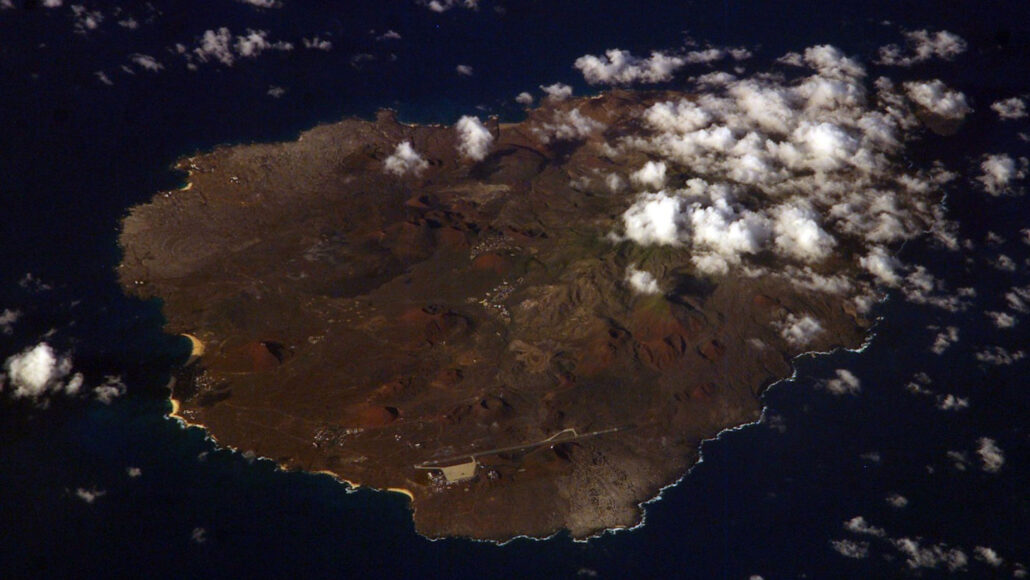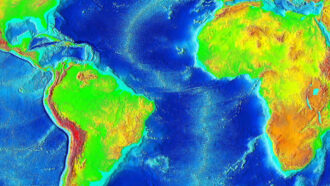Scientists find surprisingly cool 'hotspots' under Earth's crust

The hotspots that created volcanic islands such as those of Hawaii, Iceland and the Galapagos Islands may often prove surprisingly cool, a new study finds.
These findings suggest that such hotspots may not always originate from giant plumes of scorching hot rock welling up from near Earth's core as previously thought, scientists noted.
Volcanoes are typically found near the borders of tectonic plates, born from clashes between those giant slabs of rock as they drift on top of the mantle layer between Earth's core and crust. Classic examples of such volcanoes are those that make up the so-called Ring of Fire on the Pacific Rim.
However, volcanoes sometimes erupt in the middle of tectonic plates. The sources of these hotspots might be mantle plumes, mushroom-shaped pillars of hot rock ascending from the deep mantle to sear overlying material like a blowtorch. As tectonic plates wander over such plumes, geologists think chains of volcanic isles can emerge.
Previous research suggested volcanic hotspots are roughly 100 to 300 degrees Celsius (180-540 F) hotter than mid-ocean ridges, where magma rises as tectonic plates spread apart underwater. This supported the view that hotspots were heated by matter from near Earth's hot core and mid-ocean ridges by cooler mantle rock.
Now scientists find that many hotspots are dramatically cooler than previously thought, raising questions about their origins. "A substantial fraction of hotspots do not fit the classical plume model," said Vedran Lekic, a seismologist at the University of Maryland, College Park, who did not participate in this study.
In the new study, researchers analyzed the velocity of seismic waves rippling through the mantle underneath oceanic hotspots and ridges to estimate temperatures at those sites. (Seismic waves travel faster through cold rock.)
Roughly 45% of hotspots are more than 155 C (279 F) hotter than mid-ocean ridges. However, about 40% are only 50 to 136 C (90-245 F) hotter than mid-ocean ridges, not particularly hot and therefore not buoyant enough to support the active upwelling of rock from the deep mantle. What's more, roughly 15% of hotspots are especially cold, only 36 C hotter or less than mid-ocean ridges.
To shed light on the origins of these different varieties of hotspots, the scientists also examined the ratio of rarer helium-3 to more common helium-4 in their rock. (The atomic cores of helium-3 each possess just one neutron, whereas helium-4 nuclei each have two.)
Helium found in Earth's crust is mostly helium-4 arising from the breakdown of uranium and other radioactive isotopes over time, whereas helium from deep within Earth is richer in helium-3, likely from reservoirs of ancient material preserving the original ratio found between these isotopes during Earth's first days. The researchers discovered hot hotspots possessed a much higher ratio of helium-3 to helium-4 than cold hotspots did.
Although the classic model of hotspots originating from plumes welling up from the deep mantle may explain hot hotspots, including most of the famous ones, such as those underlying Hawaii, Iceland, the Galapagos, Samoa and Easter Island, "perhaps the truth is that only a few hotspots truly behave like our classical model of mantle plumes and hotspots," said study co-author Carolina Lithgow-Bertelloni, a geodynamicist at the University of California, Los Angeles.
"This reinforces what some researchers have argued previously, which is that the term 'hotspot' is misleading and that volcanoes that don't fit the plate tectonic paradigm should rather be referred to as 'melting anomalies,'" said seismologist Ross Maguire from the University of New Mexico, who did not take part in this research.
Cooler hotspots may instead originate in the upper mantle, or from slow-moving deep plumes that have more time to cool, or from deep plumes that interact with and get cooled by swirling mantle rock. "If this is real, it will be a challenge for geodynamicists to explain such a finding," said Bernhard Steinberger, a geodynamicist at the German Research Center for Geosciences in Potsdam, who was not a part of this work. "These results will doubtlessly trigger new research."
All in all, "the classical view of plumes is not so much flawed than more complex than presented 30 to 50 years ago," Lithgow-Bertelloni said.
Instead, this work "points to a much greater variety among plumes," Steinberger said. "It is kind of like whenever you get a new close-up view of a planet or moon. It has some totally unexpected features. But it is still round."
In the future, the scientists would like to analyze every hotspot in more detail to get an even better sense of their temperatures, Lithgow-Bertelloni said. They also aim to conduct more computer simulations testing various cool hotspot scenarios, she added.
The researchers detailed their findings in the Jan. 7 issue of the journal Science.Only the hottest, most buoyant mantle plumes draw from a primordial reservoir deep in the Earth
More information: Xiyuan Bao et al, On the relative temperatures of Earth's volcanic hotspots and mid-ocean ridges, Science (2022). DOI: 10.1126/science.abj8944
Journal information: Science
Provided by Inside Science, American Institute of Physics
This story is republished courtesy of Inside Science. Read the original story here. Used with permission. Inside Science is an editorially independent news service of the American Institute of Physics.
Some volcanic hot spots may have a surprisingly shallow heat source

KILEUA 2018
By Sid Perkins
JANUARY 6, 2022
Some of the world’s volcanic hot spots may be fueled by molten material that originates surprisingly close to Earth’s surface.
While some of the hottest spots are fueled by plumes of buoyant material welling up from deep within Earth, as expected, molten flows driving activity at the coolest hot spots may result from relatively shallow geophysical processes, a new study suggests.
A lot of our planet’s volcanic activity occurs at or near the edges of the tectonic plates that make up Earth’s crust (SN: 1/13/21). At mid-ocean ridges, which often form the boundaries between some tectonic plates, hot material wells up from the mantle — the hot, thick layer that lies between the Earth’s core and its crust — to create fresh crust.
But more mysterious volcanic activity also occurs in many locales in the middle of a tectonic plate, far from mid-ocean ridges, says Xiyuan Bao, a geophysicist at UCLA. The islands of Hawaii, Ascension Island in the South Atlantic and the Pitcairn Islands in the South Pacific are just a few examples of volcanoes created by such activity (SN: 1/29/19).

Volcanic activity that formed the tiny island of Ascension, in the South Atlantic, may have been fueled by shallow geologic processes rather than a deep-mantle plume, a new study suggests.
NASA/WIKIMEDIA COMMONS
Scientists suspect that many of these sites of isolated volcanism are fed by plumes of hot material rising from deep within the mantle, somewhat akin to small packets of water rising to the surface in a pot of near-boiling water (SN: 9/16/13). But a new analysis by Bao and colleagues, described in the Jan. 7 Science, suggests that some of these isolated hot spots are fueled by material that isn’t as hot as expected, casting doubt that volcanic activity there is driven by deep-mantle plumes. The results could help scientists figure out the mysterious processes unfolding at various sites of volcanism in the interior of plates.
“This study helps sort out which volcanic plumes are deep-seated and which are not,” says Keith Putirka, an igneous petrologist at California State University, Fresno who wasn’t involved in the work.
The team focused on 26 volcanic hot spots in oceanic areas that previous studies had suggested were fed by deep-mantle plumes. The researchers used seismic data to estimate the temperature of mantle material at various depths from 260 to 600 kilometers. In general, the hotter the material is, the slower that seismic waves travel through it.
The team then compared the temperature estimate for each hot spot with the average temperature of mantle material welling up at mid-ocean ridges. Because tectonic plates are pulling apart there, there’s no resistance to upwelling of hot rock from deep in the mantle. That, in turn, provides a baseline against which scientists can compare temperatures of rocks deep beneath isolated hot spots.
Temperatures at mid-ocean ridges average about 1388° Celsius (2530° Fahrenheit). For a dozen of the hot spots the team studied, deep-mantle material was more than 155° C warmer than mid-ocean ridge material, Bao and his team report. Material that hot is more than warm enough to rise to Earth’s surface, chew through overlying crust and create prodigious volcanic activity.
But for 10 hot spots, deep-mantle material ranged between only 50° C and 135° C warmer than mid-ocean ridge material, just warm enough to rise to the surface and through crust. And four of the hot spots were less than 36° C warmer than mid-ocean ridge material, which suggests the hot spot material wouldn’t be able to rise fast enough to sustain buoyancy and break through the crust. Other sorts of geophysical processes occurring closer to Earth’s surface are fueling volcanic activity at these 14 cool-to-middling hot spots, the researchers propose.
“The evidence for mantle plumes under most volcanic islands is lacking,” says Godfrey Fitton, a geochemist at the University of Edinburgh who wasn’t involved in the work. An alternate source of molten material, he suggests, could be areas where tectonic plates collided to help create past supercontinents (SN: 1/11/17).
In those crumpled zones, Fitton explains, Earth’s crust would be thicker and thus help insulate the flow of heat from the mantle to the surface. The buildup of heat in the crust, in turn, could lead to local melting of carbonate-rich rocks that could fuel volcanism. In 2020, he and his colleagues suggested that such processes have fueled volcanism at hot spots off the western coast of Africa and off the northeastern coast of Brazil for the last 50 million years or more.
CITATIONS
X. Bao et al. On the relative temperatures of Earth’s volcanic hotspots and mid-ocean ridges. Science. Vol. 375, January 7, 2022, p. 57. doi: 10.1126/science.abj8944.
A.R. Guilmarães et al. Contemporaneous intraplate magmatism on conjugate South Atlantic margins: A hotspot conundrum. Earth and Planetary Science Letters. Vol. 536, April 15, 2020, page 116147-1. doi: 10-1016/j.epsl.2020.116147.
Related Stories

No comments:
Post a Comment